人教版(2019)必修第二册Unit 2 Wildlife protection课件(17张ppt)
文档属性
| 名称 | 人教版(2019)必修第二册Unit 2 Wildlife protection课件(17张ppt) | 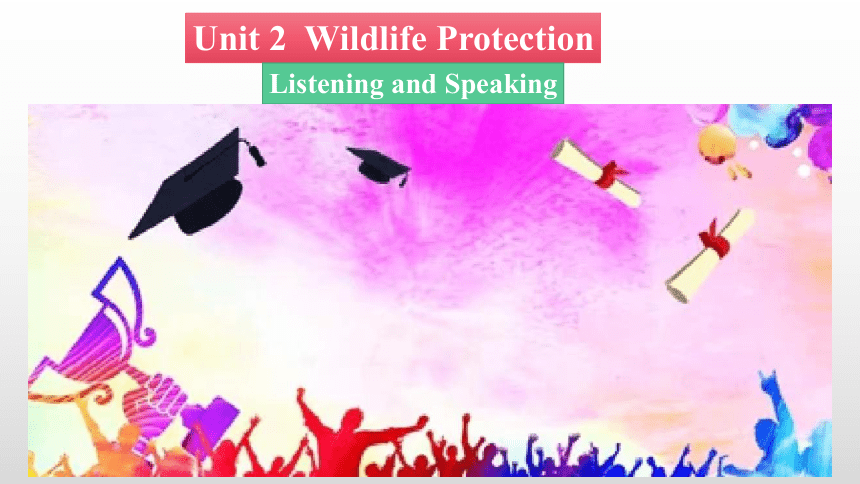 | |
| 格式 | pptx | ||
| 文件大小 | 10.8MB | ||
| 资源类型 | 教案 | ||
| 版本资源 | 人教版(2019) | ||
| 科目 | 英语 | ||
| 更新时间 | 2022-11-26 22:27:18 | ||
图片预览

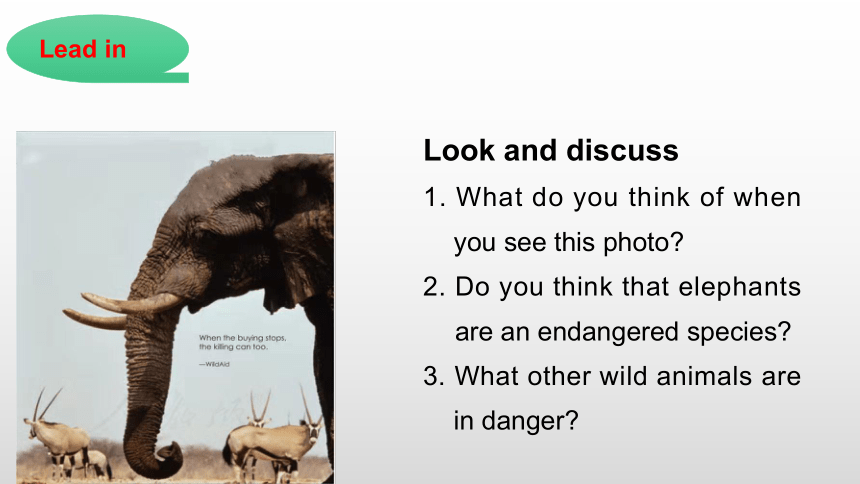
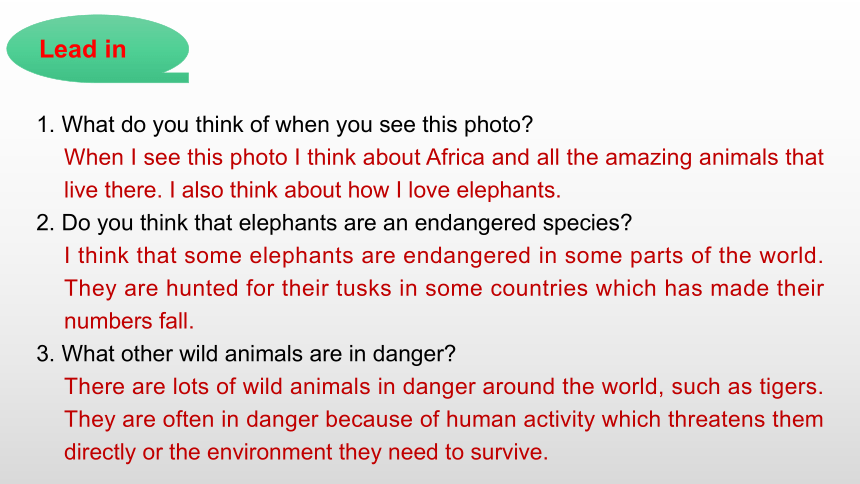
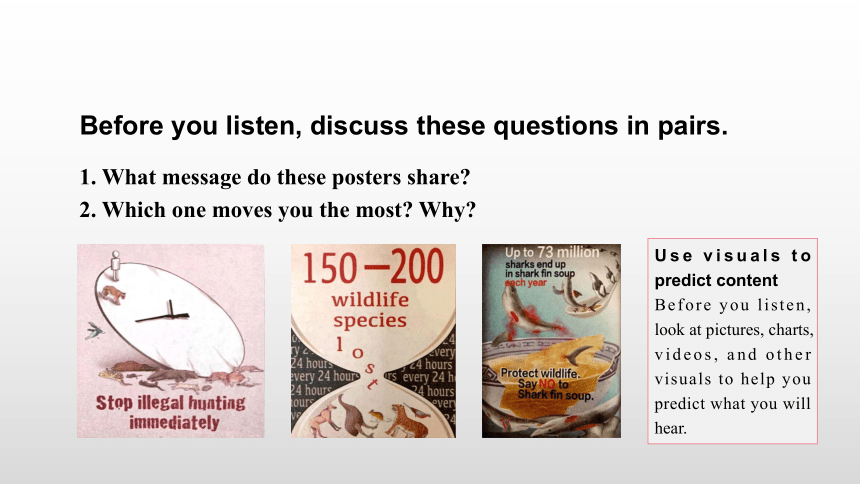
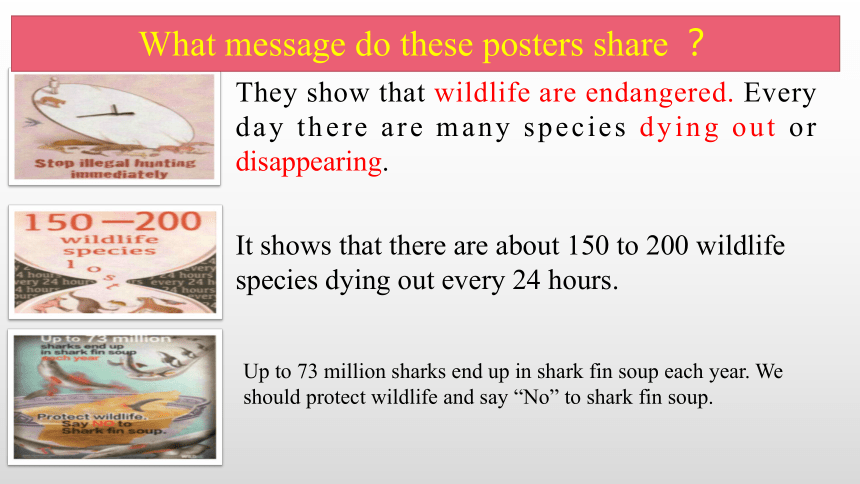
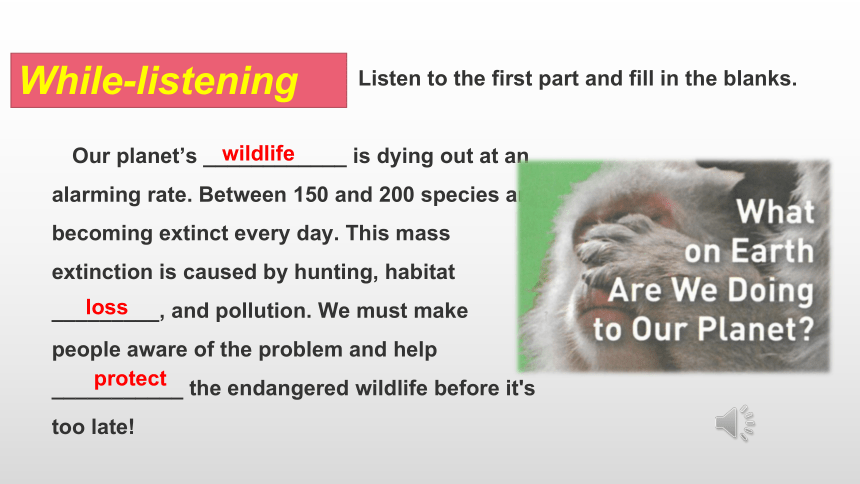
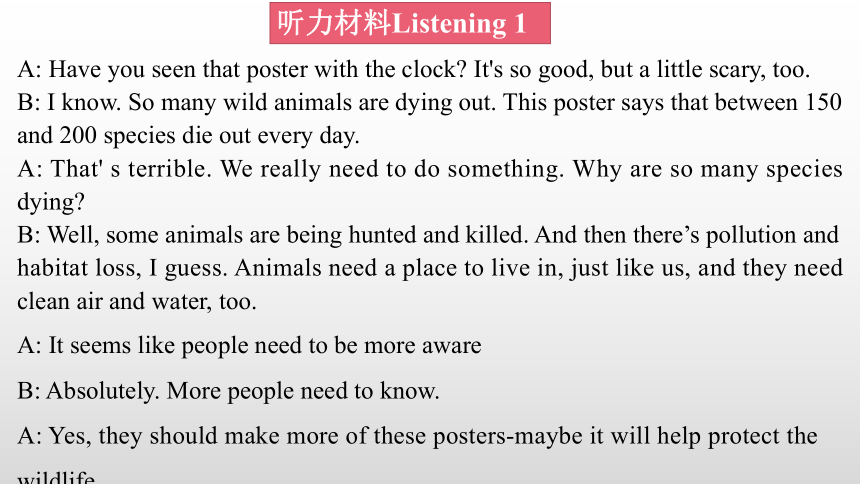
内容文字预览
(共16张PPT)
Unit 2 Wildlife Protection
Listening and Speaking
Look and discuss
1. What do you think of when you see this photo
2. Do you think that elephants are an endangered species
3. What other wild animals are in danger
Lead in
1. What do you think of when you see this photo
When I see this photo I think about Africa and all the amazing animals that live there. I also think about how I love elephants.
2. Do you think that elephants are an endangered species
I think that some elephants are endangered in some parts of the world. They are hunted for their tusks in some countries which has made their numbers fall.
3. What other wild animals are in danger
There are lots of wild animals in danger around the world, such as tigers. They are often in danger because of human activity which threatens them directly or the environment they need to survive.
Lead in
Use visuals to predict content
Before you listen, look at pictures, charts, videos, and other visuals to help you predict what you will hear.
Before you listen, discuss these questions in pairs.
1. What message do these posters share
2. Which one moves you the most Why
They show that wildlife are endangered. Every day there are many species dying out or disappearing.
What message do these posters share ?
It shows that there are about 150 to 200 wildlife species dying out every 24 hours.
Up to 73 million sharks end up in shark fin soup each year. We should protect wildlife and say “No” to shark fin soup.
Listen to the first part and fill in the blanks.
Our planet’s ____________ is dying out at an alarming rate. Between 150 and 200 species are becoming extinct every day. This mass extinction is caused by hunting, habitat _________, and pollution. We must make people aware of the problem and help ___________ the endangered wildlife before it's too late!
protect
wildlife
loss
While-listening
A: Have you seen that poster with the clock It's so good, but a little scary, too.
B: I know. So many wild animals are dying out. This poster says that between 150 and 200 species die out every day.
A: That' s terrible. We really need to do something. Why are so many species dying
B: Well, some animals are being hunted and killed. And then there’s pollution and habitat loss, I guess. Animals need a place to live in, just like us, and they need clean air and water, too.
听力材料Listening 1
A: It seems like people need to be more aware
B: Absolutely. More people need to know.
A: Yes, they should make more of these posters-maybe it will help protect the wildlife.
Listen to the second part and answer the questions.
(1) How many elephants are killed on average every day ___________
(2) What did Prince William say about China
A China has made a lot of progress.
B China can become a global leader in wildlife protection.
C China preserves its natural habitats well.
54
While-listening
Someone has to speak up for endangered animals. Some famous people, such as Chinese superstar Yao Ming and Britain’s Prince William, work hard to help. In October 2015, Prince William gave a moving speech on CCTV: "In the 33 years since I was born, we’ve lost around 70 percent of Africa’s elephant population. Of those that are left, 20,000 are killed every year. That is 54 elephants killed every single day. " That means there are elephants which are being killed right now!
听力材料Listening 2
In his speech, Prince William also praised China’s efforts to protect wildlife: "I am absolutely convinced that China can become a global leader in the protection of wildlife. "You don’t have to be Prince William or Yao Ming to speak up and do something about endangered animals. You can be the voice of wildlife protection in your area. Remember: Change begins with you.
In pairs, discuss the questions, role-play the example, and then talk about one of the animals in the photos below.
1. What do you know about the animals in the photos
2. What is being done to help them
Listening and Speaking
In pairs, discuss the questions, role-play the example, and then talk about one of the animals in the photos below.
EXAMPLE
A: I’m concerned about the African elephants. What do you know about them
B: Well, I know that they’re being hunted and their habitat is getting smaller, so they’re in danger of extinction. Elephants need large living spaces, so it’s difficult for them to adapt to the changes.
A: That’s terrible. What measures are being taken to help them
B: The authorities are under pressure to build elephant parks and tell people not to buy elephant products.
Pronunciation---stressed syllables
音节是英语当中最小的单位。每个音节含有一个音节核,通常由元音音素构成,辅音是音节的分界线。所以,音节就分成单音节、双音节和多音节。
A.单音节词
1.两辅音之间不管有多少个元音,一般都是一个音节。如:bed,seat, beau'ty。
2.两元音字母之间有一个辅音字母时,辅音字母归后一音节,如:stu'dent,la'bour。
3.有两个辅音字母时,一个辅音字母归前一音节,一个归后一音节,如:let'ter,win'ter
4.不能拆分的字母组合按字母组合划分音节。如:fa'ther,tea'cher。
一般在第一个音节重读。如:sorry, movie, cover
1.有 a-, be-, de-, re-, res-, in-, im-, en-, em-, es-, ex-, con-, com-, dis-, mis-, pre-, per-, pro-, trans- 等前缀的词,第二个音节是重音。如: be'lieve, de'cide
2.有 de-, in-, re-, con-, pre- 等前缀的重音与词义和词类有关, 一般名词的重音在第一个音节上,其它的词性在第二个音节上。如:'present pre'sent
3.有些复合词和带有前缀 re-, ex-, un-, pre-, post-, 等的词,有两个重音。如: out'side, re'tell
C. 多音节词
一般倒数第三个音节是重音。如:'difficult, oppor'tunity, 'family, e'conomy, uni'versity
alarming announcement
Practice--画出重音和次重音
1. 代表重音, 代表次重音, 代表非重音。
alarming, announcement, authority, architecture, civilization, competition, contribution, electricity, investigate, literary, recommend, responsibility, vocabulary, volunteer, refrigerator
habitat
downstairs
recommend volunteer
competition contribution
authority investigate
refrigerator vocabulary
literary architecture
civilization
electricity
responsibility
Pronunciation
2.Check your answers with another pair. Then listen and repeat.
alarming announcement authority architecture civilisation competition contribution electricity investigate literary recommend responsibility vocabulary volunteer refrigerator
3.Listen to the conversation in Activity 5, paying attention to the stress patterns of the polysyllabic words and repeat them.
Unit 2 Wildlife Protection
Listening and Speaking
Look and discuss
1. What do you think of when you see this photo
2. Do you think that elephants are an endangered species
3. What other wild animals are in danger
Lead in
1. What do you think of when you see this photo
When I see this photo I think about Africa and all the amazing animals that live there. I also think about how I love elephants.
2. Do you think that elephants are an endangered species
I think that some elephants are endangered in some parts of the world. They are hunted for their tusks in some countries which has made their numbers fall.
3. What other wild animals are in danger
There are lots of wild animals in danger around the world, such as tigers. They are often in danger because of human activity which threatens them directly or the environment they need to survive.
Lead in
Use visuals to predict content
Before you listen, look at pictures, charts, videos, and other visuals to help you predict what you will hear.
Before you listen, discuss these questions in pairs.
1. What message do these posters share
2. Which one moves you the most Why
They show that wildlife are endangered. Every day there are many species dying out or disappearing.
What message do these posters share ?
It shows that there are about 150 to 200 wildlife species dying out every 24 hours.
Up to 73 million sharks end up in shark fin soup each year. We should protect wildlife and say “No” to shark fin soup.
Listen to the first part and fill in the blanks.
Our planet’s ____________ is dying out at an alarming rate. Between 150 and 200 species are becoming extinct every day. This mass extinction is caused by hunting, habitat _________, and pollution. We must make people aware of the problem and help ___________ the endangered wildlife before it's too late!
protect
wildlife
loss
While-listening
A: Have you seen that poster with the clock It's so good, but a little scary, too.
B: I know. So many wild animals are dying out. This poster says that between 150 and 200 species die out every day.
A: That' s terrible. We really need to do something. Why are so many species dying
B: Well, some animals are being hunted and killed. And then there’s pollution and habitat loss, I guess. Animals need a place to live in, just like us, and they need clean air and water, too.
听力材料Listening 1
A: It seems like people need to be more aware
B: Absolutely. More people need to know.
A: Yes, they should make more of these posters-maybe it will help protect the wildlife.
Listen to the second part and answer the questions.
(1) How many elephants are killed on average every day ___________
(2) What did Prince William say about China
A China has made a lot of progress.
B China can become a global leader in wildlife protection.
C China preserves its natural habitats well.
54
While-listening
Someone has to speak up for endangered animals. Some famous people, such as Chinese superstar Yao Ming and Britain’s Prince William, work hard to help. In October 2015, Prince William gave a moving speech on CCTV: "In the 33 years since I was born, we’ve lost around 70 percent of Africa’s elephant population. Of those that are left, 20,000 are killed every year. That is 54 elephants killed every single day. " That means there are elephants which are being killed right now!
听力材料Listening 2
In his speech, Prince William also praised China’s efforts to protect wildlife: "I am absolutely convinced that China can become a global leader in the protection of wildlife. "You don’t have to be Prince William or Yao Ming to speak up and do something about endangered animals. You can be the voice of wildlife protection in your area. Remember: Change begins with you.
In pairs, discuss the questions, role-play the example, and then talk about one of the animals in the photos below.
1. What do you know about the animals in the photos
2. What is being done to help them
Listening and Speaking
In pairs, discuss the questions, role-play the example, and then talk about one of the animals in the photos below.
EXAMPLE
A: I’m concerned about the African elephants. What do you know about them
B: Well, I know that they’re being hunted and their habitat is getting smaller, so they’re in danger of extinction. Elephants need large living spaces, so it’s difficult for them to adapt to the changes.
A: That’s terrible. What measures are being taken to help them
B: The authorities are under pressure to build elephant parks and tell people not to buy elephant products.
Pronunciation---stressed syllables
音节是英语当中最小的单位。每个音节含有一个音节核,通常由元音音素构成,辅音是音节的分界线。所以,音节就分成单音节、双音节和多音节。
A.单音节词
1.两辅音之间不管有多少个元音,一般都是一个音节。如:bed,seat, beau'ty。
2.两元音字母之间有一个辅音字母时,辅音字母归后一音节,如:stu'dent,la'bour。
3.有两个辅音字母时,一个辅音字母归前一音节,一个归后一音节,如:let'ter,win'ter
4.不能拆分的字母组合按字母组合划分音节。如:fa'ther,tea'cher。
一般在第一个音节重读。如:sorry, movie, cover
1.有 a-, be-, de-, re-, res-, in-, im-, en-, em-, es-, ex-, con-, com-, dis-, mis-, pre-, per-, pro-, trans- 等前缀的词,第二个音节是重音。如: be'lieve, de'cide
2.有 de-, in-, re-, con-, pre- 等前缀的重音与词义和词类有关, 一般名词的重音在第一个音节上,其它的词性在第二个音节上。如:'present pre'sent
3.有些复合词和带有前缀 re-, ex-, un-, pre-, post-, 等的词,有两个重音。如: out'side, re'tell
C. 多音节词
一般倒数第三个音节是重音。如:'difficult, oppor'tunity, 'family, e'conomy, uni'versity
alarming announcement
Practice--画出重音和次重音
1. 代表重音, 代表次重音, 代表非重音。
alarming, announcement, authority, architecture, civilization, competition, contribution, electricity, investigate, literary, recommend, responsibility, vocabulary, volunteer, refrigerator
habitat
downstairs
recommend volunteer
competition contribution
authority investigate
refrigerator vocabulary
literary architecture
civilization
electricity
responsibility
Pronunciation
2.Check your answers with another pair. Then listen and repeat.
alarming announcement authority architecture civilisation competition contribution electricity investigate literary recommend responsibility vocabulary volunteer refrigerator
3.Listen to the conversation in Activity 5, paying attention to the stress patterns of the polysyllabic words and repeat them.
